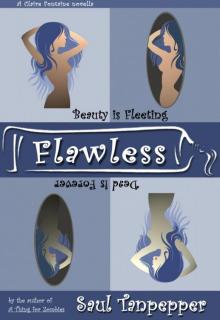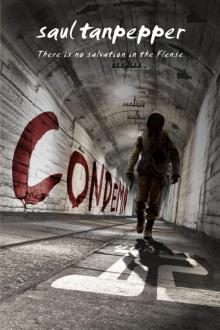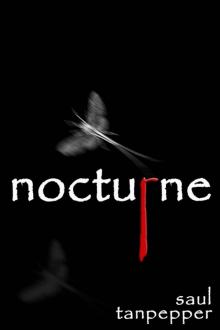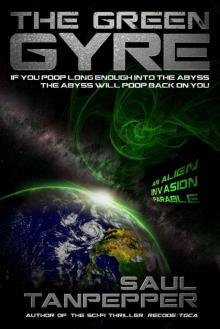- Home
- Tanpepper, Saul
The Green Gyre Page 3
The Green Gyre Read online
Page 3
What could we do?
Although most of the Greenies blew out to sea, enough of the initial flood was picked up and carried inland on countervailing winds so that in a matter of days the strange gelatinous orbs could be found in places as distant as Philadelphia. Within a week, isolated samples of it were identified as far west as Chicago and as far south as Washington, DC.
Professional scientists from dozens of governments and thousands of universities and biotech companies requested some of the material be sent to them for analysis in their laboratories. Thousands more amateur researchers made similar requests, although none of these, of course, and few of the others were ever granted.
Once it became apparent the Greenies didn’t pose an immediate military threat, didn’t kill us or hatch baby alien lizards inside of us or explode or catch fire or take out the Internet or give us superpowers or turn us into zombies, suddenly everyone wanted some of it for themselves. Eager collectors flocked to New York City in such numbers that the George Washington Bridge was jammed solid for nearly two straight weeks.
About a month after being deposited here, the Greenies started to change.
The blobs began to harden and reform, generating loose, amorphous, pseudo-crystalline structures. These retained the same buoyancy in air, but because of a newly-developed stickiness — a strange sort of magnetism or static electricity that the physicists were unable to explain — they tended to adhere lightly to any surface they contacted. By mid-August, lower Manhattan resembled a birthday cake covered in green sugar sprinkles and the Statue of Liberty and odd-shaped Christmas tree.
The Greenies seemed especially attracted to moving objects — automobiles, people, animals — which greatly accelerated their dispersal rate.
The clusters could be easily separated into individual units and, if left alone, readily and spontaneously fell apart. They weren’t brittle, however. They couldn’t be smashed. And whatever fetal shadows Mark Williams thought he’d seen swimming within their pearlescent interiors turned out to be nothing at all, just a trick of the light.
Smaller and smaller particles of it found their way into the basements and attics of hundred-year-old brownstones, reached the deepest ventilation shafts of the highest skyscrapers, and even managed to breach the industrial clean rooms of high tech companies. There was considerable concern expressed by safety engineers and aeronautics mechanics, but as far as anyone could determine, Greenies appeared to be completely unobtrusive (except for the fact that they were infuriatingly intrusive). They didn’t seem to interfere with devices, whether the most delicate timepiece or the most complicated engine. Medical doctors and toxicologists warned folks about exposure to the material, but for all their outcry, Greenies appeared to be completely inert. Early experiments to establish their harmfulness yielded little evidence that they were. They didn’t seem to be infective, mutagenic, teratogenic, or psychotropic, at least when tested on lab mice. They didn’t replicate on their own, nor could they be induced to replicate by any of the means known to terrestrial species.
Nevertheless, prophylactic measures were taken. Surgeon’s masks became a popular fashion accessory, as were rubber boots.
The blobs which had been blown out to sea also crystallized. These attached themselves to the hulls of overseas freighters, prompting foreign governments to demand painstaking inspections and the implementation of prohibitive decontamination procedures prior to docking. Even so, it was inevitable that the material would find its way to distant shores simply by floating there on the surface of the water or by being carried on the wings of migratory birds.
Our military and those of foreign governments did not rest in their efforts to study Greenies and those responsible for delivering them to us. They took every opportunity to prepare for the expected invasion and any other contingency they could think of. Nightmare scenarios were drawn up and presented to Congress, and the public was entreated to support the purchase and stockpiling of ballistic weaponry, global missile shields, and flamethrowers. Planetary defense was no longer just a catchphrase.
The citizenry also did their small part to prepare. Individual shotgun sales increased sixty thousand percent and applications for CCW permits increased a hundredfold.
Months passed, but still no attack came. There was no further visit, no attempt at communication. We scanned the entire energy spectrum from the sub-gamma to the ultra-high radio, all without detecting a single out-of-place blip.
Panic and chaos eventually coalesced into anger. Righteous indignation spread almost as quickly as a Nigerian phishing scam. Protests were mounted, cries of retaliation were sounded.
But against what exactly? And how?
Eventually, these emotions also waned. Worn thin by the routine of everyday life, angst gave way to ennui. Our obsessive stargazing had produced no answers, did not provoke the return of the aliens. The skies remained clear of Greenies, and the only things to fall from it were the red and yellow leaves of autumn.
The green substance dispersed more and more over the globe, until one had to look hard for it to find any. Many people forgot about it altogether: out of sight, out of mind. Central Park reclaimed its former, if less verdant, beauty. Winter came and covered the bridges and ponds and pathways in white. For most people, life returned to normal, or at least a semblance of normal.
Until the second ship appeared over Bogota six months later.
Militaries scrambled to respond, then backpedalled with excuses of restraint when not a single fighter plane managed to arrive in time to engage the enemy. As before, the ship had come and gone within the space of a half hour.
A couple months after Bogota, a third ship arrived. Adelaide, this time.
Then Madrid, weeks later. By then, nobody cared.
Each event progressed as if by script: a deposit of Greenies, all of which behaved in the expected way: dispersing in the wind, eventually crystallizing, then breaking apart and adhering to every conceivable surface. Our cycle of emotions, from panic to anger to boredom, became shorter and shorter until it seemed we had become completely inured by the unfulfilled promise of an invasion that never actually materialized. Not a single person was ever abducted, no matter how fervently one might have wished for it.
By the first anniversary of the original encounter, the alien freighters would be appearing nearly daily, sometimes two or more simultaneously over different parts of the globe. Even Lubbock had its one encounter, much to the amusement of the twice-visited New Yorkers; the pile of Greenies deposited there was reportedly twenty-seven feet tall. Unfortunately, the Guinness Book of World Records was unable to verify the claim.
The world was quickly becoming covered in Greenies. And still the scientists had no clue what the stuff was or what it was meant to do.
They tried breaking it down with chemicals and enzymes, but the experiments yielded little information of any use. The material was obviously organic, a loose, but highly resistant amalgamation of fats, sugars and amino acids, their chemical bonds unusually nonreactive. It was clearly itself not living, nor did it appear to be derived from living tissue. It wouldn’t grow, neither on Petri dishes which contained a thousand different variations of nutrients, nor in soils from a hundred different locales. And nothing would grow on it.
They tried infusing it. It absorbed nothing. They tried burning it in super-heated kilns or hitting it with high-energy laser beams, but while it fizzled and bubbled and gave off a noxious odor along with a tarry black smoke, these too weren’t very helpful results.
They scanned it with electron microscopes and x-rays and microwaves before deciding that these approaches were also wastes of time. Lethal voltages of electricity just made it buzz.
It wasn’t radioactive, didn’t seem to hold heat, didn’t have any consistent measurable light diffractive properties. Its ion spectrograph confirmed what little we already knew about its organic basis, but its exact molecular structure remained frustratingly elusive.
Meanwhile, the milit
ary’s attempts to discern the nature and intent of the ships which had carried it here were just as futile. Only the SETI scientists seemed in any way pleased by their observations. They had concluded that the aliens might have come from a place in a distant galaxy known as the Red Gyre.
(Might, they emphasized. They couldn’t say beyond fourteen-point-three percent certainty. Which, for them, was actually pretty good.)
The first “breakthrough” came right around the time the fourth ship showed up, roughly nine months after the first. The discovery was not made by a scientist or a four-star general. It did not derive from the calculations of some theoretical mathematician or the indecipherable prophecies of an ancient Central American empire. Rather, it came by way of a humble reporter. And a homeless man.
The name of the latter, so he claimed, was Willie. This bearded giant lived on the outskirts of Manhattan, making his bed wherever convenient, wherever his shiftless shambles found him at the end of any particular day. He was heavily befouled by grease and ketchup, his head was shaggy, filthy and flea-ridden, and he was half a step from turning completely feral. His voice was a broken mumble, his words barely coherent. But at least he didn’t drink, didn’t smoke, didn’t chew, and didn’t swear. He was adorned in what, later, would be identified as a once-expensive pair of Armani slacks (most likely stolen off some poor hapless soul). His high-end shoes lacked laces and were held onto his feet with duct tape.
The reason he had come to anyone’s attention at all is because he was observed eating a Greenie.
When asked on camera what it was like, he responded (with the assistance of subtitles and probably a liberal amount of translation), “It doesn’t taste like much. Kind of chewy, actually, like strawberry gum that’s already been chewed on a while.”
“Aren’t you afraid it’ll make you sick?”
“No. I’ve been eating it for a few weeks now and haven’t yet had a problem.”
“Can’t you afford real food? What about the soup kitchens?”
“Oh yeah, but handouts have been terrible lately. When I can afford them, I eat the weiners over on 49th Street. They have the best mustard there. And bathrooms. But Greenies are free.”
“Okay, but why? What made you start eating them?”
“They were there, so why not?” answered Willie. Clearly, he was mad, for such an answer could only be made by — and make sense to — a man who had completely flipped his lid.
The reporter held up one of the familiar crystals and gave it a tentative whiff, shrugged, then shook her head. She waggled her eyebrows mischievously at the camera, as if she’d just had an evil epiphany. “Would you mind eating one right now, Willie? For the world to see?”
That night, on CNN, the world watched the first televised meal of Greenies.
A local medical doctor warned us that it was unwise to follow Willie’s lead, at least without first consulting with one’s personal physician. “We still know far-too little about this mysterious substance and whether it might interact or interfere with prescribed medications. Those with allergies should probably avoid all contact with them.”
The reporter closed with these comments: “Why did this alien species bring Greenies to our planet? What are they, exactly? Could they be dormant spores? After all this time, probably not. Weapons? Doubtful. But maybe, just maybe, they’re something good after all.”
The clip concluded with another shot of the Greenie Mountain Man, as he was quickly dubbed on Twitter, swallowing yet another of the crystals.
The next morning, a radio station in Boston announced a contest to see who would eat one. The prize was tickets to a Taylor Swift concert. The contest was cancelled because the response crashed the cell phone towers.
What little of the Greenies still to be found in New York was quickly hoarded.
Speculation spread that the Greenies were heaven-sent, that God was the one piloting the spaceships. Only God could be so big, they reasoned. For the more agnostically-inclined, Greenies were a blessing by a benevolent alien race which had been sent here on a “humanitarian mission to cure hunger.”
There then followed a period of joyous celebration in the streets. Evidence that the material contained very few calories and nothing of any nutritive value made absolutely no difference to anyone. Didn’t that basically describe rice? At least Greenies tasted like something.
Nobody even knew if Greenies could be digested (and nobody bothered to ask Willie); they just assumed.
Suddenly, Greenie-eating was all the rage. The finest restaurants began to offer it on their menus: Salad Greenies with House Dressing, Sautéed Greenies with Lobster Sauce, Greenies à la Mode. Greenie tea.
On the fashion circuit, green was the new fall color; it was the new black.
Some enterprising college boys from Oslo collected and boxed the stuff up when their city was next to be anointed by the aliens. They began selling the stuff on the internet and became overnight millionaires. They were lucky enough to have embarked on their bit of profiteering when they did, for if they had started just a few weeks later, when the alien shipments were coming more or less on a daily basis, and when the wide availability of the stuff dropped its street value to practically nothing, they would have failed miserably.
A mail order-certified nutritionist did the talk show circuit touting the Greenie diet. The physician who had made the original warning on the Willie segment tried to counter these claims with warnings of unknown risks, but his message was effectively drowned out or ignored.
On a warm spring day in May, eleven months after the first visit, the world marked a singular event with a remarkable, if perhaps unverified, claim: someone had calculated that there were now enough Greenies to sustain every single man, woman, and child on the planet for a year. “Now is the day we celebrate the end of hunger,” went out the bold proclamation, as if it also harkened the end to poverty and war.
Surprisingly, if perhaps only to the most cynical, goodwill really did begin to spread over the world. Military stockpiles were disassembled. The border with Canada was finally reopened and former Americans were welcomed back with open arms.
Greenies — the aliens — attained heroic stature. They became rock stars, angels, Happy Meal toys. Costumes depicting the species’ imagined appearance became very popular. The zombie industry fell into a near-fatal decline.
For most people, Greenies didn’t replace their everyday food, it merely supplemented it. But for the most destitute of populations, the overabundant Greenies was all they had to eat. It was in these latter groups that the first problems started cropping up: gastric ailments, including alternating bouts of constipation and bloody diarrhea, severe lethargy, loss of consciousness. And death.
Death by the most agonizing route imaginable.
The diet-spouting pseudo-nutritionist quite suddenly vanished from the airwaves, chased by accusations he was skimming funds from his non-profit organization. He was last rumored to be building schools somewhere in Mongolia. People now flocked to hear what the once-ridiculed physician had been trying to preach about the risks. Greenies — the aliens — became reviled as haters of humanity. God was cursed.
And zombie-lovers celebrated the sudden resurgence of the undead.
By the time they found Manhattan’s Mountain Man Willie — better known as Mark Williams, thanks to a timely tip from a well-read blog owned and written by a former entrepreneur from Union City, California — he was deathly sick and suffering terribly.
The reporter’s camera recorded his final heartbreaking moments. His stomach was grossly distended, his skin pocked by weeping cancers, his hair falling out in clumps. He was a shrunken shell of a man in an overlarge package. Incredibly, even in his weakened state, he continued to shove Greenies into his mouth. He said he couldn’t stop eating them.
The sensitive microphone picked up his last words just before he expired, including this enigmatic utterance: “We shouldn’t have gimbled in the gyre.”
A world-wide ban on
Greenie-eating had been enacted, of course, but by then the damage had already been done.
It seemed that the naysayers had been correct from the very beginning: the aliens had put the Greenies here to destroy us.
Nobody seemed to recall that it was we, not them, who had conceived of eating the crap in the first place.
* * *
The final ship appeared in the sky above Billings, Montana, on a drizzly afternoon in June, almost exactly a year to the day after the first one arrived over Manhattan. It came, just like the others, hovered a few thousand feet up, and released its torrent of Greenies to the ground. For those who were present there that day, there would be universal agreement regarding the vessel’s size: it was big, yes, but certainly not inconceivably so. “Huge” seemed to be a perfectly suitable term. The Montana sky, now, that’s ginormous.
Forty-one minutes after it arrived, the ship was gone. The Greenies it left behind began almost immediately to blow across the prairie. They settled into nooks and corners, fell down gopher holes, and rolled beneath unpainted wooden stairs and aluminum horse troughs. They crystallized, broke apart, and the pieces attached themselves and spread even further. Where they settled, dust blew onto them and buried them. They would not decompose, not for another ten thousand years. The scientists had at least figured this much out.
From the International Space Station, high above the surface of the planet, the world had turned a uniform shade of teal. Even the seas and the deserts. It was the same shade its sister planets had recently assumed.
* * *
Having unloaded its cargo, the captain of the final ship gave the order to rejoin the convoy. From somewhere far below it, the bay doors clanked shut and the surface of the planet receded away.
Out of curiosity, the alien checked its logs and confirmed that it had visited this particular rock on at least one previous occasion. It had been a while, roughly seventy-five million years in the past. It chuckled, thinking how the place had looked vaguely familiar. One doesn’t easily forget such ugliness in such a desolate region of space.

 Flawless, a Claire Fontaine novella
Flawless, a Claire Fontaine novella Condemn (BUNKER 12 Book 2)
Condemn (BUNKER 12 Book 2) Nocturne
Nocturne The Headhunter (Shorting the Undead & Other Horrors)
The Headhunter (Shorting the Undead & Other Horrors) S.W. Tanpepper's GAMELAND: Season Two Omnibus (Episodes 9-11)
S.W. Tanpepper's GAMELAND: Season Two Omnibus (Episodes 9-11) The Green Gyre
The Green Gyre